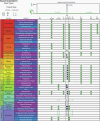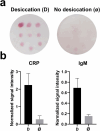Molecular and physiological changes in the SpaceX Inspiration4 civilian crew
- PMID: 38862026
- PMCID: PMC11357997
- DOI: 10.1038/s41586-024-07648-x
Molecular and physiological changes in the SpaceX Inspiration4 civilian crew
Abstract
Human spaceflight has historically been managed by government agencies, such as in the NASA Twins Study1, but new commercial spaceflight opportunities have opened spaceflight to a broader population. In 2021, the SpaceX Inspiration4 mission launched the first all-civilian crew to low Earth orbit, which included the youngest American astronaut (aged 29), new in-flight experimental technologies (handheld ultrasound imaging, smartwatch wearables and immune profiling), ocular alignment measurements and new protocols for in-depth, multi-omic molecular and cellular profiling. Here we report the primary findings from the 3-day spaceflight mission, which induced a broad range of physiological and stress responses, neurovestibular changes indexed by ocular misalignment, and altered neurocognitive functioning, some of which match those of long-term spaceflight2, but almost all of which did not differ from baseline (pre-flight) after return to Earth. Overall, these preliminary civilian spaceflight data suggest that short-duration missions do not pose a significant health risk, and moreover present a rich opportunity to measure the earliest phases of adaptation to spaceflight in the human body at anatomical, cellular, physiological and cognitive levels. Finally, these methods and results lay the foundation for an open, rapidly expanding biomedical database for astronauts3, which can inform countermeasure development for both private and government-sponsored space missions.
© 2024. The Author(s).
Conflict of interest statement
C.E.M. is a co-founder of BioAstra. The remaining authors declare no competing interests.
Figures















Similar articles
-
Development of Progressively Earth-Independent Medical Operations to Enable NASA Exploration Missions.Wilderness Environ Med. 2025 Sep;36(1_suppl):95S-103S. doi: 10.1177/10806032241310386. Epub 2025 Jan 27. Wilderness Environ Med. 2025. PMID: 39865932
-
A second space age spanning omics, platforms and medicine across orbits.Nature. 2024 Aug;632(8027):995-1008. doi: 10.1038/s41586-024-07586-8. Epub 2024 Jun 11. Nature. 2024. PMID: 38862027 Free PMC article. Review.
-
Immersive gamma music as a tool for enhancing glymphatic clearance in astronauts while improving their mental well-being.Life Sci Space Res (Amst). 2025 Feb;44:86-89. doi: 10.1016/j.lssr.2024.10.011. Epub 2024 Oct 28. Life Sci Space Res (Amst). 2025. PMID: 39864916
-
The Black Book of Psychotropic Dosing and Monitoring.Psychopharmacol Bull. 2024 Jul 8;54(3):8-59. Psychopharmacol Bull. 2024. PMID: 38993656 Free PMC article. Review.
-
Microbiology of human spaceflight: microbial responses to mechanical forces that impact health and habitat sustainability.Microbiol Mol Biol Rev. 2024 Sep 26;88(3):e0014423. doi: 10.1128/mmbr.00144-23. Epub 2024 Aug 19. Microbiol Mol Biol Rev. 2024. PMID: 39158275 Free PMC article. Review.
Cited by
-
Telomeric RNA (TERRA) increases in response to spaceflight and high-altitude climbing.Commun Biol. 2024 Jun 11;7(1):698. doi: 10.1038/s42003-024-06014-x. Commun Biol. 2024. PMID: 38862827 Free PMC article.
-
Feeding the cosmos: tackling personalized space nutrition and the leaky gut challenge.NPJ Microgravity. 2025 Jul 18;11(1):45. doi: 10.1038/s41526-025-00490-z. NPJ Microgravity. 2025. PMID: 40681523 Free PMC article.
-
Collection of biospecimens from the inspiration4 mission establishes the standards for the space omics and medical atlas (SOMA).Nat Commun. 2024 Jun 11;15(1):4964. doi: 10.1038/s41467-024-48806-z. Nat Commun. 2024. PMID: 38862509 Free PMC article.
-
NASA open science data repository: open science for life in space.Nucleic Acids Res. 2025 Jan 6;53(D1):D1697-D1710. doi: 10.1093/nar/gkae1116. Nucleic Acids Res. 2025. PMID: 39558178 Free PMC article.
-
The GENESTAR manual for biospecimen collection biobanking and omics data generation from commercial space missions.NPJ Microgravity. 2025 May 14;11(1):16. doi: 10.1038/s41526-025-00472-1. NPJ Microgravity. 2025. PMID: 40368955 Free PMC article.
References
-
- Urquieta, E., Wu, J., Hury, J. & Donoviel, D. Establishment of an open biomedical database for commercial spaceflight. Nat. Med.28, 611–612 (2022). - PubMed
MeSH terms
Grants and funding
LinkOut - more resources
Full Text Sources

